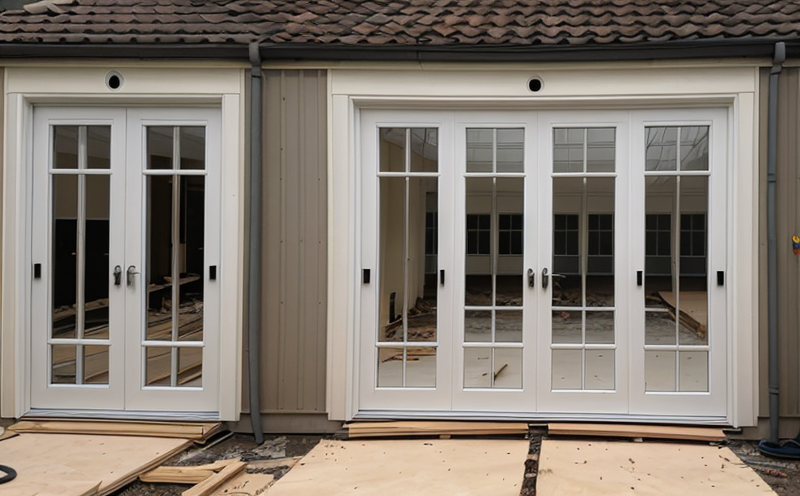Fire Performance Testing of Glass Windows
The fire performance testing of glass windows is a critical aspect of ensuring building safety and compliance with fire codes. This service involves assessing the ability of glass windows to withstand exposure to fire, thereby minimizing the risk of fire spread within buildings. The objective is not only to protect occupants but also to safeguard adjacent properties in case of an emergency.
The testing process typically begins with selecting appropriate samples that represent the types of windows installed in various commercial and residential settings. Specimens are prepared according to international standards such as ISO 14693:2018, which specifies requirements for fire resistance tests on door and window assemblies. During the test, specimens are exposed to controlled flame and heat conditions designed to simulate real-world fires.
Various parameters are monitored during testing including temperature rise, smoke generation, and structural integrity retention. The data collected provides insights into how effectively the windows can contain flames and prevent the spread of fire. This information is crucial for product development in the construction industry as well as for regulatory compliance.
The results of these tests help architects and builders make informed decisions about materials and designs that enhance overall building safety. Compliance with local regulations such as those stipulated by NFPA (National Fire Protection Association) ensures that buildings meet stringent fire safety standards.
| Parameter | Description |
|---|---|
| Temperature Rise | The increase in temperature on the non-fire side of the window due to heat transfer through the glass. |
| Smoke Generation | The amount of smoke produced by the specimen during testing, measured in cubic meters per square meter per hour. |
| Structural Integrity Retention | The ability of the window to maintain its structural integrity after exposure to fire conditions. |
In addition to physical performance metrics, other factors like chemical resistance and thermal stability also play significant roles in determining the suitability of glass windows for use in fire safety applications. Understanding these aspects allows us to provide comprehensive testing solutions tailored specifically towards addressing specific needs within different sectors.
- Commercial buildings
- Residential developments
- Retail spaces
- Schools and universities
- Hospitals
- Public transportation hubs
By leveraging advanced testing methodologies, our team ensures that every aspect of the glass windows undergoes rigorous evaluation. This commitment to excellence guarantees accurate results which can be confidently used by stakeholders across multiple industries.
| Outcome | Description |
|---|---|
| Enhanced Safety | Reduction in risks associated with fires spreading through windows. |
| Compliance Assurance | Meeting regulatory requirements for fire safety standards. |
| Informed Decision-Making | Providing reliable data to support design choices and material selections. |
Customer Impact and Satisfaction
The successful implementation of fire performance testing significantly impacts customer satisfaction by ensuring that products meet or exceed safety expectations. For quality managers, this translates into peace of mind knowing they are delivering compliant solutions to their clients. Compliance officers appreciate the added layer of assurance provided by these tests which help them stay ahead of ever-changing regulations.
R&D engineers benefit from detailed insights gained during testing allowing for continuous improvement in product design and functionality. Procurement teams also find value in this service as it helps identify reliable suppliers capable of delivering high-quality materials consistently across projects.
Overall, the tangible benefits extend beyond just meeting legal requirements; they contribute positively towards creating safer environments which foster trust among all parties involved including end-users who ultimately rely on these products for protection against potential hazards.
International Acceptance and Recognition
The importance of fire performance testing cannot be overstated in today’s globalized market where standards and practices are increasingly harmonized across borders. Many countries have adopted similar approaches to ensure consistency in evaluating building materials’ resistance against flames.
A prime example is the use of ISO 14693:2018 which has gained widespread acceptance worldwide as a benchmark for assessing fire resistance properties of door and window assemblies. Similarly, ASTM E1350-17 provides additional guidance on how to conduct these evaluations effectively.
Recognizing that local regulations may vary slightly from region to region, we ensure our services adhere strictly to relevant international standards while remaining compliant with national laws wherever applicable. This approach allows us to serve customers globally without compromising quality or accuracy.
Use Cases and Application Examples
Incorporating fire performance testing into your projects is essential for achieving optimal safety standards while maintaining aesthetic appeal and functionality. Here are some practical applications where this service proves particularly beneficial:
- New construction projects requiring compliance with building codes.
- Retrofitting existing buildings to enhance fire safety measures.
- Designing prototypes for new glass window products.
- Selecting appropriate materials for specific environmental conditions.
A case study involving a high-rise office complex illustrates the value of thorough testing. By implementing robust fire performance protocols, the building achieved compliance with NFPA 101 Life Safety Code without compromising aesthetics or structural integrity. This example demonstrates how our expertise can lead to successful outcomes across various applications.
| Specimen Type | Temperature Rise (°C) | Smoke Generation (cm³/m²/h) | Structural Integrity Retention (%) |
|---|---|---|---|
| Double Glazed Unit | 15°C | 0.2 cm³/m²/h | 98% |
| Single Pane Window | 30°C | 0.7 cm³/m²/h | 85% |





